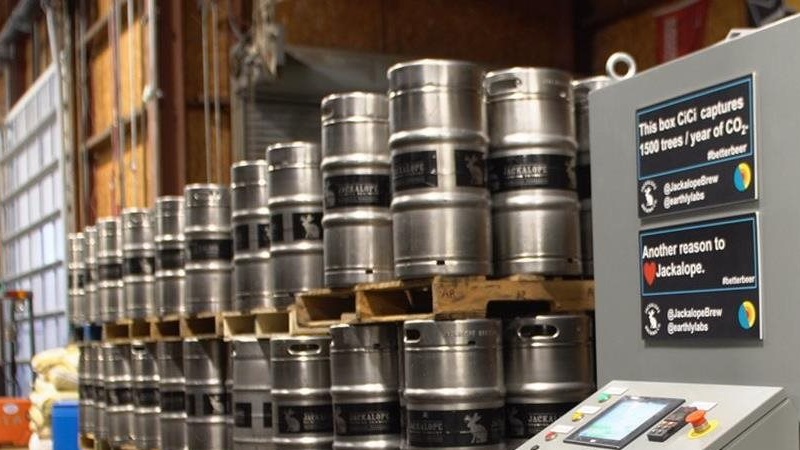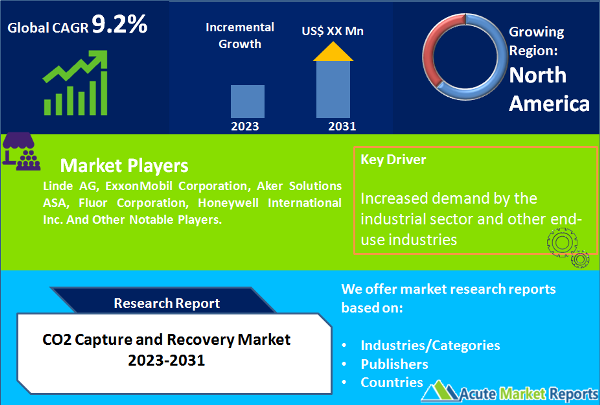
The global CO2 capture and recovery market is expected to grow at a steady rate in the coming years, with a projected CAGR of over 9.2% during the forecast period 2025-2033. The market is driven by increasing government regulations and policies to control carbon emissions from various industries. The CO2 capture and recovery process involves capturing carbon dioxide from industrial processes such as power generation, oil and gas production, and manufacturing, and then recovering and reusing it. The growing focus on reducing carbon emissions and increasing awareness of the negative impact of greenhouse gases on the environment and climate change are driving the demand for CO2 capture and recovery technologies. Furthermore, the increasing adoption of enhanced oil recovery techniques is expected to boost market growth in the coming years. The use of CO2 in enhanced oil recovery helps to increase oil production and reduce the carbon footprint of oil and gas production activities. This is driving the demand for CO2 capture and recovery systems in the oil and gas industry. Overall, the CO2 capture and recovery market is expected to see steady growth in the coming years, driven by increasing government regulations and policies, growing awareness of the need to reduce carbon emissions, and the increasing adoption of enhanced oil recovery techniques. However, the market may face challenges such as high capital costs, technological challenges, and the lack of infrastructure for CO2 transport and storage.

Government Regulations and Policies
Government regulations and policies aimed at reducing carbon emissions are one of the major drivers of the CO2 capture and recovery market. Governments around the world are implementing policies and regulations to control carbon emissions from various industries, such as power generation, oil and gas, and manufacturing. For instance, in the United States, the Environmental Protection Agency (EPA) has implemented the Clean Power Plan, which aims to reduce carbon emissions from power plants. Similarly, the European Union has set a target of reducing carbon emissions by 55% by 2033.
Growing Awareness of the Need to Reduce Carbon Emissions
The growing awareness of the need to reduce carbon emissions is driving the demand for CO2 capture and recovery technologies. Increasingly, consumers, investors, and companies are recognizing the negative impact of greenhouse gases on the environment and climate change. As a result, there is a growing demand for clean energy and sustainable practices across various industries. CO2 capture and recovery technologies offer a way to reduce carbon emissions from industrial processes and contribute to a cleaner environment.
Increasing Adoption of Enhanced Oil Recovery Techniques
The increasing adoption of enhanced oil recovery (EOR) techniques is driving the demand for CO2 capture and recovery systems in the oil and gas industry. CO2 is used in EOR to increase oil production while reducing the carbon footprint of oil and gas production activities. The use of CO2 for EOR is expected to increase in the coming years, driven by the growing demand for oil and gas and the need to reduce carbon emissions. According to a report by the Global CCS Institute, the use of CO2 for EOR could account for up to 70% of the demand for CO2 capture and storage by 2050.
High Costs Associated with CO2 Capture and Recovery
One of the major restraints of the CO2 capture and recovery market is the high costs associated with implementing CO2 capture and recovery technologies. The installation and operation of CO2 capture and recovery systems require significant investment and operational expenses. According to a report by the International Energy Agency, the cost of CO2 capture and storage systems can range from $50 to $100 per ton of CO2 captured. This cost is significantly higher than the current price of carbon credits in most markets, which makes it economically unviable for many companies to invest in these technologies. Additionally, the high costs associated with CO2 capture and recovery technologies can impact the competitiveness of industries, particularly in developing countries where companies may not have the financial resources to invest in these technologies. The high costs associated with CO2 capture and recovery technologies remain a major challenge for the widespread adoption of these technologies, and efforts are ongoing to find ways to reduce these costs and make the technologies more economically viable.
The Liquid Media to Continue its Dominance in Market by Type During the Forecast Period
The CO2 capture and recovery market can be segmented by type of technology used, with two main categories: liquid media and solid media. Liquid media-based CO2 capture technologies use chemical solvents, such as amines, to capture CO2 from industrial flue gases. These solvents react with CO2 to form stable compounds that can be easily separated, releasing pure CO2. Liquid media-based CO2 capture technologies currently hold the highest revenue share in the market, owing to their widespread adoption across various industries, including power generation, chemical processing, and oil and gas. Additionally, the liquid media-based CO2 capture and recovery segment is expected to maintain its dominant position in the market during the forecast period of 2025 to 2033, with a high compound annual growth rate (CAGR). Solid media-based CO2 capture technologies, on the other hand, use materials such as zeolites or metal-organic frameworks to adsorb CO2. These materials have a high surface area and can capture CO2 by physical or chemical adsorption. The solid media-based CO2 capture segment is expected to grow at a significant CAGR due to the increasing demand for more energy-efficient and cost-effective CO2 capture and recovery systems. Despite their lower revenue share compared to liquid media-based technologies, solid media-based CO2 capture technologies hold significant potential for reducing the costs associated with CO2 capture and recovery, making them a viable option for industries seeking to reduce their carbon footprint.
Energy Fuel Segment to Dominate the Market by Application
In terms of application, the CO2 capture and recovery market can be segmented into F&B, greenhouse, energy fuel, and others. In terms of revenue, the energy fuel segment held the largest market share in 2024. This can be attributed to the increasing adoption of carbon capture technologies in the oil and gas industry to reduce carbon emissions. The F&B segment is expected to follow closely in terms of revenue, driven by the increasing demand for carbonated beverages and the adoption of sustainable measures to reduce carbon footprint. In terms of CAGR, the greenhouse segment is expected to witness the highest growth rate during the forecast period of 2025 to 2033. This can be attributed to the increasing adoption of sustainable agriculture practices and the growing demand for food. The energy fuel segment is also expected to witness significant growth owing to the increasing adoption of carbon capture technologies in the oil and gas industry. The F&B industry is expected to witness significant growth during the forecast period due to the increasing demand for carbonated beverages and rising concerns over the carbon footprint of the industry. According to a report by the International Energy Agency, the F&B industry is responsible for around 7% of global CO2 emissions. This has prompted the industry to adopt sustainable measures such as CO2 capture and recovery to reduce its carbon footprint.
North America Leading the Revenues, APAC to Emerge as the Growth Leader
The CO2 capture and recovery market are witnessing significant growth in various regions of the world. North America, with its strong focus on reducing carbon emissions, has been a prominent market for CO2 capture and recovery. The region is projected to continue to dominate the market during the forecast period, with a high revenue share and a substantial CAGR. The U.S. is the leading country in the region, accounting for the majority of the market share. The country has been implementing various initiatives to reduce its carbon footprint and promote sustainable energy sources, driving the demand for CO2 capture and recovery technologies. The Asia Pacific region is also witnessing significant growth in the CO2 capture and recovery market. The region is expected to have a high CAGR during the forecast period, driven by the growing demand for CO2 capture and recovery technologies in developing countries such as China and India. The increasing industrialization and urbanization in these countries have led to an increase in carbon emissions, making it necessary to adopt CO2 capture and recovery technologies.
Market Competition to Intensify During the Forecast Period
The CO2 capture and recovery market is highly competitive, with several players vying for market share. Companies are focusing on research and development, strategic collaborations, and partnerships to strengthen their position in the market. One of the leading players in the market is Air Products and Chemicals, Inc., which has developed a range of products and solutions for CO2 capture and recovery. The company has also invested in strategic collaborations and partnerships to expand its product portfolio and geographic reach. Another key player is Mitsubishi Heavy Industries, Ltd., which offers a range of technologies for CO2 capture and recovery, including its proprietary KS-1 solvent. The company has also partnered with several other players in the market to develop new solutions and expand its customer base. Other prominent players in the market include Linde AG, ExxonMobil Corporation, Aker Solutions ASA, Fluor Corporation, and Honeywell International Inc. These companies are focusing on developing new technologies and solutions to meet the growing demand for CO2 capture and recovery. In terms of key strategies, companies are focusing on partnerships and collaborations to develop new technologies and expand their geographic reach. For example, in 2021, Air Products and Chemicals, Inc. announced a partnership with ACWA Power to develop a new project for CO2 capture and recovery in Saudi Arabia. In addition, companies are investing in research and development to develop new, more efficient technologies for CO2 capture and recovery. This includes the development of new solvents and other materials, as well as the integration of artificial intelligence and other advanced technologies into CO2 capture and recovery systems.
Historical & Forecast Period
This study report represents analysis of each segment from 2023 to 2033 considering 2024 as the base year. Compounded Annual Growth Rate (CAGR) for each of the respective segments estimated for the forecast period of 2025 to 2033.
The current report comprises of quantitative market estimations for each micro market for every geographical region and qualitative market analysis such as micro and macro environment analysis, market trends, competitive intelligence, segment analysis, porters five force model, top winning strategies, top investment markets, emerging trends and technological analysis, case studies, strategic conclusions and recommendations and other key market insights.
Research Methodology
The complete research study was conducted in three phases, namely: secondary research, primary research, and expert panel review. key data point that enables the estimation of CO2 Capture and Recovery market are as follows:
Market forecast was performed through proprietary software that analyzes various qualitative and quantitative factors. Growth rate and CAGR were estimated through intensive secondary and primary research. Data triangulation across various data points provides accuracy across various analyzed market segments in the report. Application of both top down and bottom-up approach for validation of market estimation assures logical, methodical and mathematical consistency of the quantitative data.
| ATTRIBUTE | DETAILS |
|---|---|
| Research Period | 2023-2033 |
| Base Year | 2024 |
| Forecast Period | 2025-2033 |
| Historical Year | 2023 |
| Unit | USD Million |
| Segmentation | |
Type
| |
Application
| |
|
Region Segment (2023-2033; US$ Million)
|
Key questions answered in this report